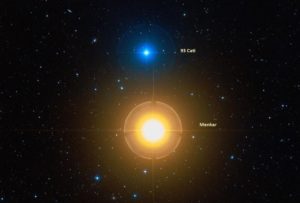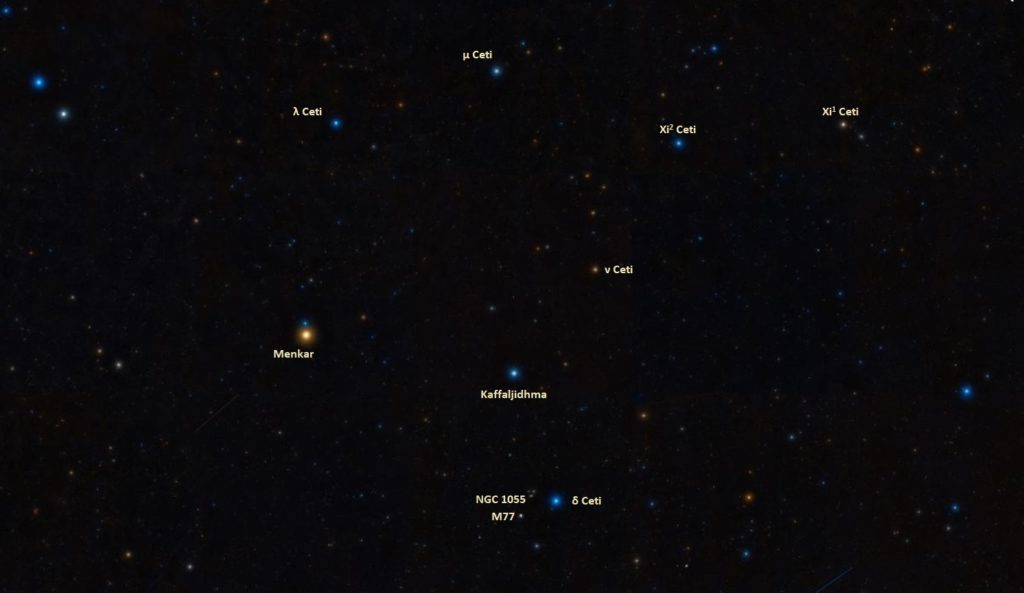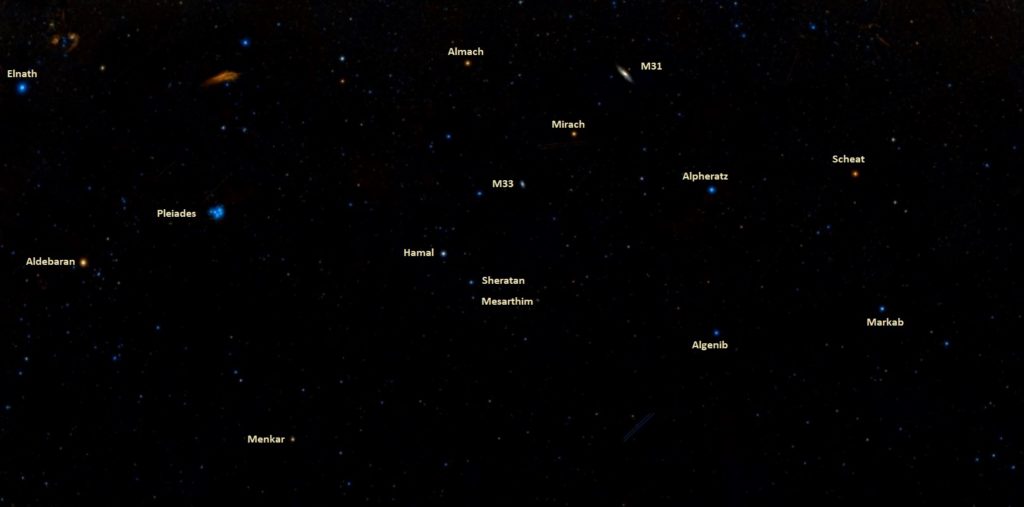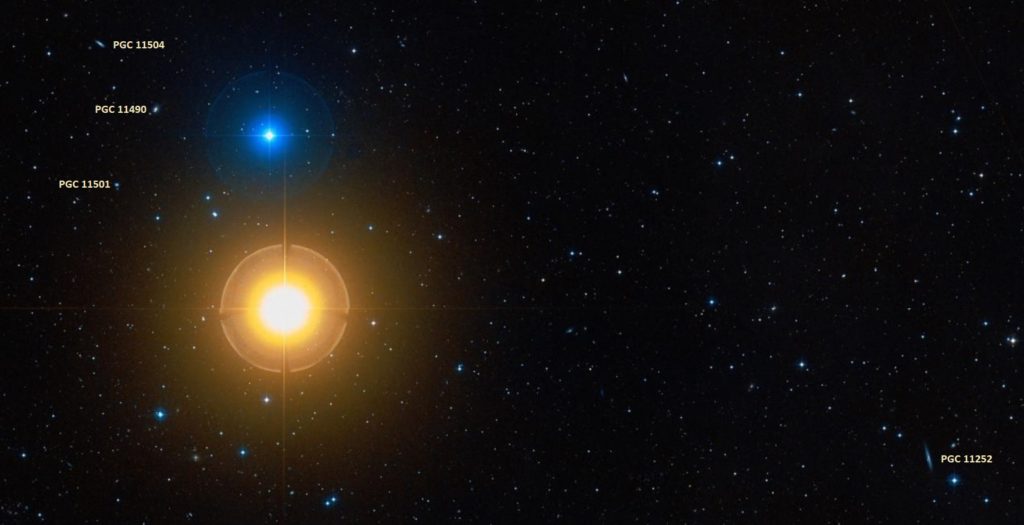Menkar, Alpha Ceti (α Cet), is a red giant star located in the constellation Cetus, the Whale. It is one of the stars that outline the head of Cetus. With an apparent magnitude of 2.53, it is the second brightest star in the constellation, after Diphda. Menkar lies at an approximate distance of 249 light years from Earth.
Star type
Menkar has the stellar classification M1.5 IIIa, indicating a luminous red giant. The star has an absolute magnitude of -3.2. With an effective temperature of 3,795 K, it is about 1,455 times more luminous than the Sun, but most of its energy output is in the invisible infrared.
Menkar has a mass 2.3 times that of the Sun and has expanded to a size of about 89 solar radii as it evolved away from the main sequence. It is currently on the asymptotic giant branch (AGB), the late stage in a life of a star with up to nine solar masses. AGB stars have inert carbon-hydrogen cores surrounded by inner layers where helium is being fused into carbon and outer layers where hydrogen is fused into helium. Their outer envelopes are highly convective. As it evolves through this phase, Menkar may begin to pulsate with increasingly large amplitudes, like its neighbour Mira, until its outer layers are cast into space to form a planetary nebula and leaving behind a hot white dwarf.
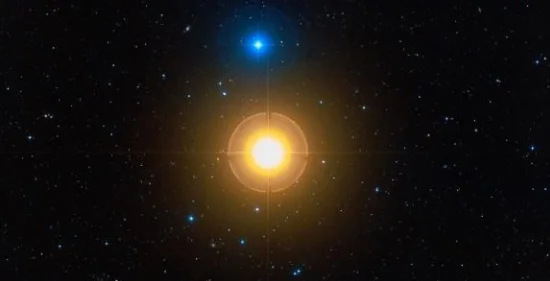
Menkar (Alpha Ceti), image: Wikisky
Menkar is a relatively slow spinner, with a projected rotational velocity of 6.9 km/s.
The star is a suspected long-period variable. A 2002 study found it to vary in brightness, but only very slightly, by about one hundredth of a magnitude.
Facts
Menkar and the brighter Diphda (Beta Ceti), a star in the tail of Cetus, are among the 58 bright stars selected for navigation. These stars are particularly useful in the field of celestial navigation because they are both bright and easy to recognize. Menkar and Diphda are part of a group of navigational stars that lie in the equatorial region of the eastern celestial hemisphere. The group also includes Hamal in the constellation Aries, Aldebaran and Elnath in Taurus, Pollux in Gemini, Sirius and Adhara in Canis Major, Procyon in Canis Minor, Alphard in Hydra, and four bright stars in Orion: Rigel, Betelgeuse, Bellatrix and Alnilam.
Menkar and the fainter (mag. 5.62) blue-white star 93 Ceti form a striking visual double but are not physically related. 93 Ceti lies at a much greater distance (550 light years) from Earth and has a luminosity 321 times that of the Sun.
Menkar was memorably used in the episode “Space Seed” (1967) of Star Trek: The Original Series and in the feature film Star Trek II: The Wrath of Khan (1982). In the series, Khan Noonien Singh and his followers, a group of genetically engineered humans, are exiled to an uncolonized planet called Ceti Alpha V (orbiting Ceti Alpha, i.e. Alpha Ceti), where they are found by Captain Clark Terrell and Commander Pavel Chekhov 15 years later in the feature film. The planet is revisited in Star Trek: Enterprise, in the episode “Twilight” (2003), where it is the home of what is left of humankind after the Xindi destroy the Earth in an alternate timeline.
Name
The name Menkar (pronunciation: /ˈmɛŋkɑːr/) is derived from the Arabic manħar, meaning “nostril.” It refers to the nostril of Cetus, the Sea Monster. Alpha Ceti once shared this name with Lambda Ceti, its neighbour in the head of Cetus. Even though the name suggests otherwise, Menkar marks the jaws of Cetus.
The name was officially approved by the International Astronomical Union’s (IAU) Working Group on Star Names (WGSN) on June 30, 2016.
The Chinese know Menkar as 天囷一 (Tiān Qūn yī), the First Star of Circular Celestial Granary. The Chinese asterism called Circular Celestial Granary is part of the Stomach mansion, one of the mansions of the White Tiger. The asterism is formed by Menkar with the stars Kappa2 Ceti, Lambda Ceti, Mu Ceti, Xi1 Ceti, Xi2 Ceti, Nu Ceti, Kaffaljidhma (Gamma Ceti), Delta Ceti, 75 Ceti, 70 Ceti, 63 Ceti, and 66 Ceti.
The 15th century Timurid astronomer Ulugh Beg and 16th century Arabic astronomer Al Tizini called the star Al Kaff al Jidhmah, meaning “”the cut-short hand.” The name was used for all the stars in the head of Cetus – Alpha Ceti, Gamma Ceti, Delta Ceti, Lambda Ceti, Mu Ceti, Xi1 Ceti and Xi2 Ceti – but today only applies to Gamma Ceti, formally known as Kaffaljidhma.
Location
Menkar is the brightest in a relatively inconspicuous circle of stars that outline the head of Cetus, the Whale. It can be found using the bright stars in the nearby constellations Andromeda and Aries. A line extended from Mirach, the middle star in a chain of three brightest stars in Andromeda, between Hamal and Sheratan, the brightest stars in Aries, points in the direction of the head of Cetus.
The three Andromeda stars are easily identified because Alpheratz sits at the northeast vertex of the Great Square of Pegasus, a prominent asterism also formed by the bright Pegasus stars Algenib, Markab and Scheat. Alpheratz is the first in a line of three stars between the constellations Pegasus and Perseus. Mirach, the middle star in the chain, is also commonly used to find the Andromeda Galaxy (Messier 31) and the Triangulum Galaxy (Messier 33), while Almach makes it easy to identify Mirfak and Algol in Perseus.
The Aries stars – Hamal and Sheratan – are easy to identify because they form a distinct flat triangle asterism with the fainter Mesarthim.
On a clear night, Menkar can also be found using Aldebaran and the stars of the Hyades cluster, which outline the head of Taurus. The V-shaped head of the celestial Bull points in the direction of Menkar.
There are several faint galaxies appearing in the same field of view as the star: PGC 11504, PGC 11490, PGC 11501, and PGC 11252.
Constellation
Menkar is located in the constellation Cetus. Representing the sea monster from the Greek myth of Andromeda, the constellation is the fourth largest in the sky, after Hydra, Virgo, and Ursa Major. Also known as the Whale, Cetus occupies 1,231 square degrees between Pisces, Aries, Aquarius, Eridanus, Taurus, Fornax, and Sculptor. It is one of the Greek constellations, first listed by the astronomer Claudius Ptolemy of Alexandria in the 2nd century CE.
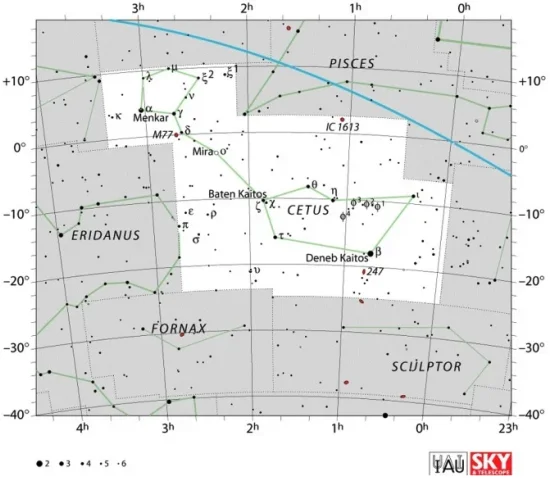
Cetus constellation map by IAU and Sky&Telescope magazine
Cetus is home to the variable stars Mira (Omicron Ceti) and UV Ceti, each a prototype for its own class of variables, the red dwarf LHS 1140 with two orbiting planets, and Tau Ceti, the nearest single G-star (solar analogue) to the Sun, which hosts five candidate planets. It also hosts Earendel (WHL0137-LS), the earliest and most distant star discovered as of March 2022.
Notable deep sky objects in Cetus include the barred spiral galaxy Messier 77 (Cetus A), the spiral galaxies NGC 247, NGC 1042, NGC 1035, and NGC 1055, the irregular dwarf galaxy IC 1613, and the bright planetary nebula catalogued as NGC 246 and known as the Skull Nebula.
The best time of year to observe the stars and deep sky objects in Cetus is during the month of November.
The 10 brightest stars in Cetus are Diphda (Beta Ceti, mag. 2.02), Menkar (Alpha Ceti, mag. 2.53), Eta Ceti (mag. 3.446), Kaffaljidhma (Gamma Ceti, mag. 3.47), Tau Ceti (mag. 3.50), Iota Ceti (mag. 3.562), Theta Ceti (mag. 3.60), Baten Kaitos (Zeta Ceti, mag. 3.742), Upsilon Ceti (mag. 3.95), and Delta Ceti (mag. 4.06). The pulsating variable star Mira (Omicron Ceti, mag. 2.0 – 10.1) is sometimes among the brightest stars in the constellation and at other times it is invisible to the unaided eye.
Menkar – Alpha Ceti
| Spectral class | M1.5 IIIa |
| Variable type | Long period variable (suspected) or none |
| U-B colour index | +1.93 |
| B-V colour index | +1.64 |
| Apparent magnitude | 2.53 |
| Absolute magnitude | –3.2 ± 0.3 |
| Distance | 249 ± 8 light years (76 ± 3 parsecs) |
| Parallax | 13.09 ± 0.44 mas |
| Radial velocity | –26.08 ± 0.02 km/s |
| Proper motion | RA: -10.41 ± 0.51 mas/yr |
| Dec.: -76.85 ± 0.36 | |
| Mass | 2.3 ± 0.2 M☉ |
| Luminosity | 1,455 ± 328 L☉ |
| Radius | 89 ± 5 R☉ |
| Temperature | 3,795 ± 70 K |
| Metallicity | 0.00 ± 0.30 dex |
| Rotational velocity | 6.9 km/s |
| Surface gravity | 0.9 ± 0.1 cgs |
| Constellation | Cetus |
| Right ascension | 03h 02m 16.77307s |
| Declination | +04° 05′ 23.0596″ |
| Names and designations | Menkar, Menkab, Alpha Ceti, α Cet, 92 Ceti, HD 18884, HR 911, HIP 14135, BD+03° 419, SAO 110920, PPM 146172, FK5 107, GC 3643, GCRV 1688, IRAS 02596+0353, IRAS 02597+0354, 2MASS J03021680+0405226, PLX 629.00, TYC 58-1618-1 |
